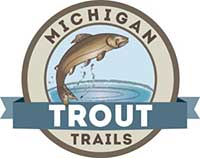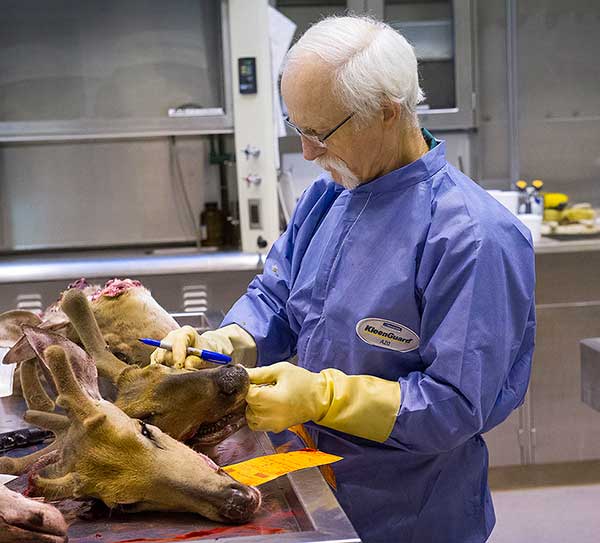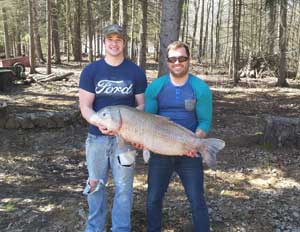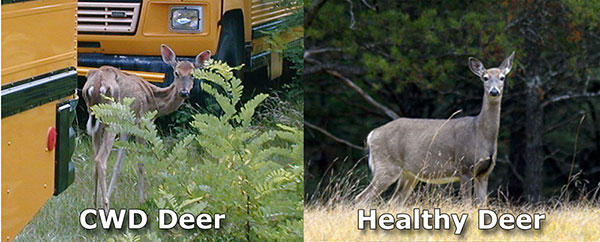- Details
(Provided by Michigan DNR)
 Michigan Trout TrailsThe Michigan DNR has launched a new tool on its website that showcases quality trout streams and lakes accessible to anglers. Trout Trails is a comprehensive map featuring fisheries biologist-verified trout waters that often are lesser known, but considered outstanding destination points.
Michigan Trout TrailsThe Michigan DNR has launched a new tool on its website that showcases quality trout streams and lakes accessible to anglers. Trout Trails is a comprehensive map featuring fisheries biologist-verified trout waters that often are lesser known, but considered outstanding destination points.
Interested anglers should visit www.michigan.gov/trouttrails to access the Web-based Trout Trails application. Please note, Trout Trails is not a downloadable app, but it is compatible with all types of electronic devices.
- Details
(Provided by Michigan DNR)
 Wildlife Veterinarian Working with Deer CarcassesSince the discovery in May of a free-ranging deer infected with chronic wasting disease in Ingham County, the Michigan DNR has been hard at work sampling deer from the immediate area for additional signs of the disease and putting into effect emergency precautions to prevent as much as possible spread of the disease.
Wildlife Veterinarian Working with Deer CarcassesSince the discovery in May of a free-ranging deer infected with chronic wasting disease in Ingham County, the Michigan DNR has been hard at work sampling deer from the immediate area for additional signs of the disease and putting into effect emergency precautions to prevent as much as possible spread of the disease.
So far, no additional infected animals have been found.
Chronic wasting disease is an unusual neurological disorder that affects members of the deer family. CWD is caused by prions - mutating proteins in the animals nervous system - not a bacteria or virus. A form of transmissible spongiform encephalopathy, similar to mad cow disease, CWD causes lesions in the brain. Infected animals exhibit uncharacteristic behavior - they lose their fear of humans, for instance - and gradually waste away. CWD has never been shown to cause illness in humans.
- Details
(Provided by Michigan DNR)
The Michigan DNR recently confirmed two new state-record fish for black buffalo and white perch. This marks the second and third state-record fish caught in 2015.
 Sage Colegrove and state record black buffalo.The state record for black buffalo was broken by a fish caught by Sage Colegrove of Muskegon on the Grand River in Ottawa County April 12 while bowfishing. The fish weighed 44.54 pounds and measured 38.50 inches.
Sage Colegrove and state record black buffalo.The state record for black buffalo was broken by a fish caught by Sage Colegrove of Muskegon on the Grand River in Ottawa County April 12 while bowfishing. The fish weighed 44.54 pounds and measured 38.50 inches.
The record was verified by Rich O'Neal, a DNR fisheries biologist in Muskegon.
The previous state-record black buffalo weighed 41.25 pounds and measured 38.25 inches.
- Details
(Provided by Michigan DNR)
The Michigan Natural Resources Commission decided to eliminate the harvest of antlerless deer during the archery season for hunters using deer or deer combo licenses in the Upper Peninsula.
The restriction, which does not affect the firearm deer season, will be in effect for the 2015-2016 season. The NRC made the decision at its monthly meeting in Monroe, Michigan, in an effort to aid the Upper Peninsula's struggling deer population, which has declined to a level comparable to the early 1980s following three successive winters with severe conditions.
There have been roughly 5,000 to 6,300 antlerless deer harvested in the U.P. by archers over each of the past four years.
Although deer regulations currently are on a three-year cycle, elements such as weather and disease can cause regulations to be reviewed mid-cycle and adjusted when appropriate.
- Details
 Michigan confirms states first case of chronic wasting disease in deer
Michigan confirms states first case of chronic wasting disease in deer
The Michigan DNR and Agriculture and Rural Development confirmed that a free-ranging deer in Meridian Township (Ingham County) has tested positive for chronic wasting disease (CWD), a fatal neurological disease that affects white-tailed deer, mule deer, elk and moose.
Ingham County is located southeast of Lansing.
This is the first time the disease has been found in Michigan's free-ranging deer population. In 2008 a white-tailed deer from a privately owned cervid (POC) facility in Kent County tested positive for CWD.
The animal was observed last month wandering around a Meridian Township residence and showing signs of illness. The homeowner contacted the Meridian Township Police Department, who then sent an officer to euthanize the animal. The deer was collected by a DNR wildlife biologist and delivered for initial testing to the DNR Wildlife Disease Laboratory at the Michigan State University Diagnostic Center for Population and Animal Health in Lansing, Michigan. After initial tests were positive, samples were forwarded to the U.S. Department of Agricultureís National Veterinary Services Laboratory in Ames, Iowa, for final confirmation. The Michigan DNR received that positive confirmation last week.


